Corporate Governance Implications from Global Financial Crisis Report
VerifiedAdded on 2022/10/18
|6
|1280
|17
Report
AI Summary
This report delves into the critical aspects of corporate governance, examining the causes and implications of corporate collapses, particularly in the context of the global financial crisis. The report begins by analyzing historical cases of corporate failures in Australia, including those of Alan Bond, Laurie Connell (Rothwells), and Girvan Corporation, identifying the underlying reasons for their downfall and discussing whether modern corporate governance regulations could have prevented these outcomes. The analysis extends to the collapse of financial institutions, exploring how failures in corporate governance contributed to the global financial crisis. The report highlights the significance of effective corporate governance practices in mitigating risks, ensuring financial stability, and protecting stakeholder interests. It emphasizes the importance of board oversight, risk management, and ethical conduct in fostering a sustainable business environment. The report references relevant literature and provides insights into the role of corporate governance in preventing future financial crises and promoting responsible corporate behavior.
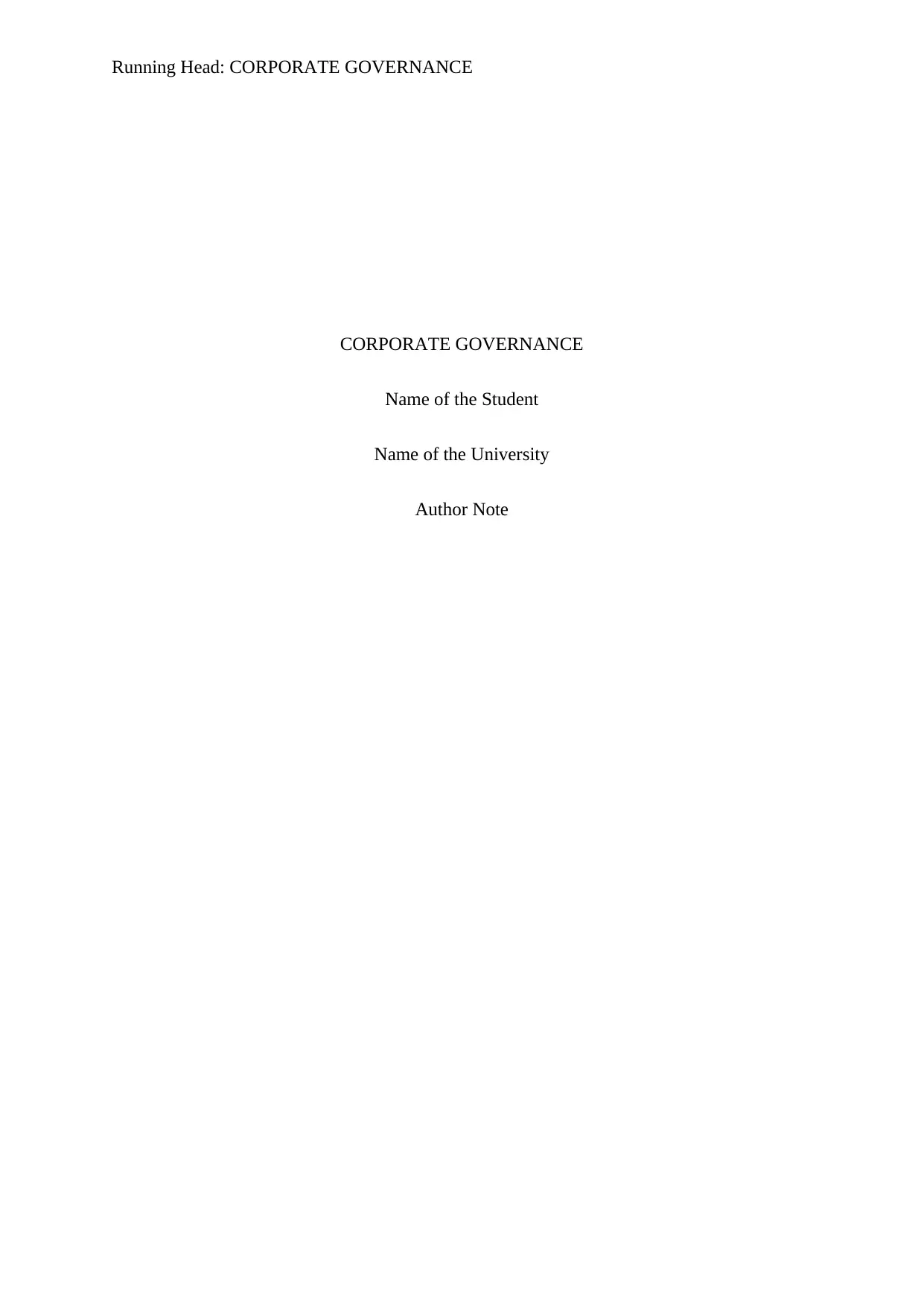
Running Head: CORPORATE GOVERNANCE
CORPORATE GOVERNANCE
Name of the Student
Name of the University
Author Note
CORPORATE GOVERNANCE
Name of the Student
Name of the University
Author Note
Paraphrase This Document
Need a fresh take? Get an instant paraphrase of this document with our AI Paraphraser
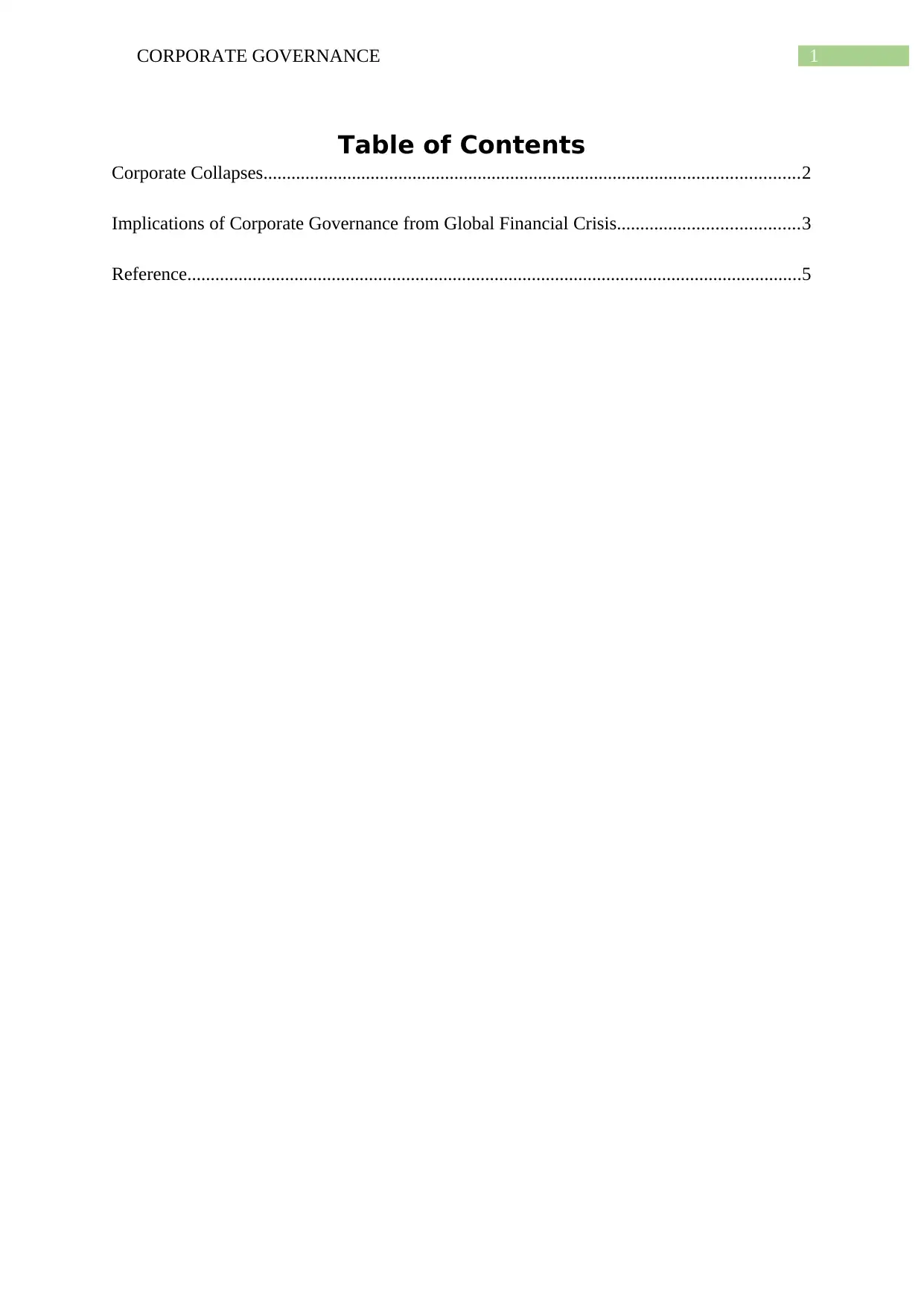
1CORPORATE GOVERNANCE
Table of Contents
Corporate Collapses...................................................................................................................2
Implications of Corporate Governance from Global Financial Crisis.......................................3
Reference....................................................................................................................................5
Table of Contents
Corporate Collapses...................................................................................................................2
Implications of Corporate Governance from Global Financial Crisis.......................................3
Reference....................................................................................................................................5
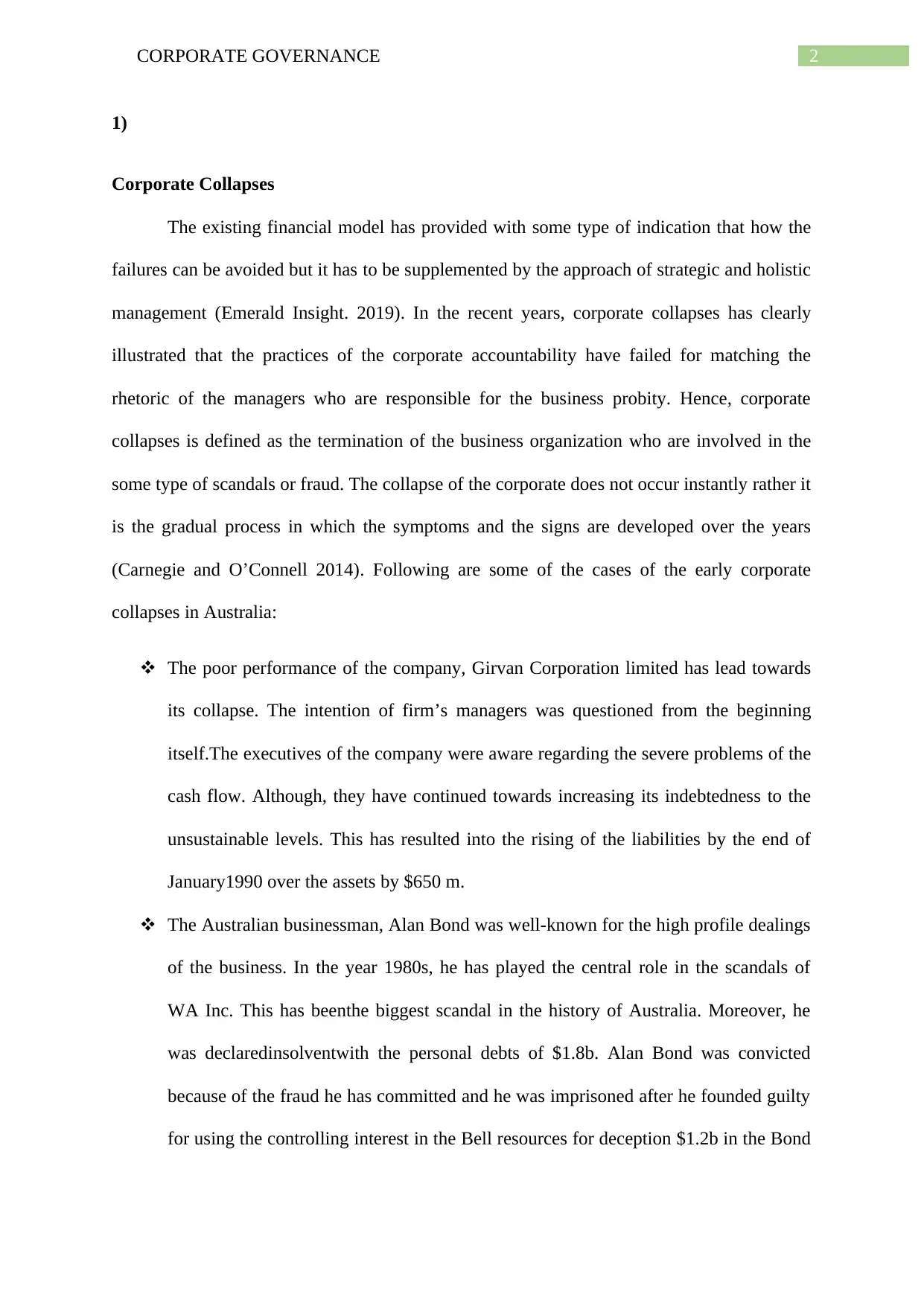
2CORPORATE GOVERNANCE
1)
Corporate Collapses
The existing financial model has provided with some type of indication that how the
failures can be avoided but it has to be supplemented by the approach of strategic and holistic
management (Emerald Insight. 2019). In the recent years, corporate collapses has clearly
illustrated that the practices of the corporate accountability have failed for matching the
rhetoric of the managers who are responsible for the business probity. Hence, corporate
collapses is defined as the termination of the business organization who are involved in the
some type of scandals or fraud. The collapse of the corporate does not occur instantly rather it
is the gradual process in which the symptoms and the signs are developed over the years
(Carnegie and O’Connell 2014). Following are some of the cases of the early corporate
collapses in Australia:
The poor performance of the company, Girvan Corporation limited has lead towards
its collapse. The intention of firm’s managers was questioned from the beginning
itself.The executives of the company were aware regarding the severe problems of the
cash flow. Although, they have continued towards increasing its indebtedness to the
unsustainable levels. This has resulted into the rising of the liabilities by the end of
January1990 over the assets by $650 m.
The Australian businessman, Alan Bond was well-known for the high profile dealings
of the business. In the year 1980s, he has played the central role in the scandals of
WA Inc. This has beenthe biggest scandal in the history of Australia. Moreover, he
was declaredinsolventwith the personal debts of $1.8b. Alan Bond was convicted
because of the fraud he has committed and he was imprisoned after he founded guilty
for using the controlling interest in the Bell resources for deception $1.2b in the Bond
1)
Corporate Collapses
The existing financial model has provided with some type of indication that how the
failures can be avoided but it has to be supplemented by the approach of strategic and holistic
management (Emerald Insight. 2019). In the recent years, corporate collapses has clearly
illustrated that the practices of the corporate accountability have failed for matching the
rhetoric of the managers who are responsible for the business probity. Hence, corporate
collapses is defined as the termination of the business organization who are involved in the
some type of scandals or fraud. The collapse of the corporate does not occur instantly rather it
is the gradual process in which the symptoms and the signs are developed over the years
(Carnegie and O’Connell 2014). Following are some of the cases of the early corporate
collapses in Australia:
The poor performance of the company, Girvan Corporation limited has lead towards
its collapse. The intention of firm’s managers was questioned from the beginning
itself.The executives of the company were aware regarding the severe problems of the
cash flow. Although, they have continued towards increasing its indebtedness to the
unsustainable levels. This has resulted into the rising of the liabilities by the end of
January1990 over the assets by $650 m.
The Australian businessman, Alan Bond was well-known for the high profile dealings
of the business. In the year 1980s, he has played the central role in the scandals of
WA Inc. This has beenthe biggest scandal in the history of Australia. Moreover, he
was declaredinsolventwith the personal debts of $1.8b. Alan Bond was convicted
because of the fraud he has committed and he was imprisoned after he founded guilty
for using the controlling interest in the Bell resources for deception $1.2b in the Bond
⊘ This is a preview!⊘
Do you want full access?
Subscribe today to unlock all pages.

Trusted by 1+ million students worldwide
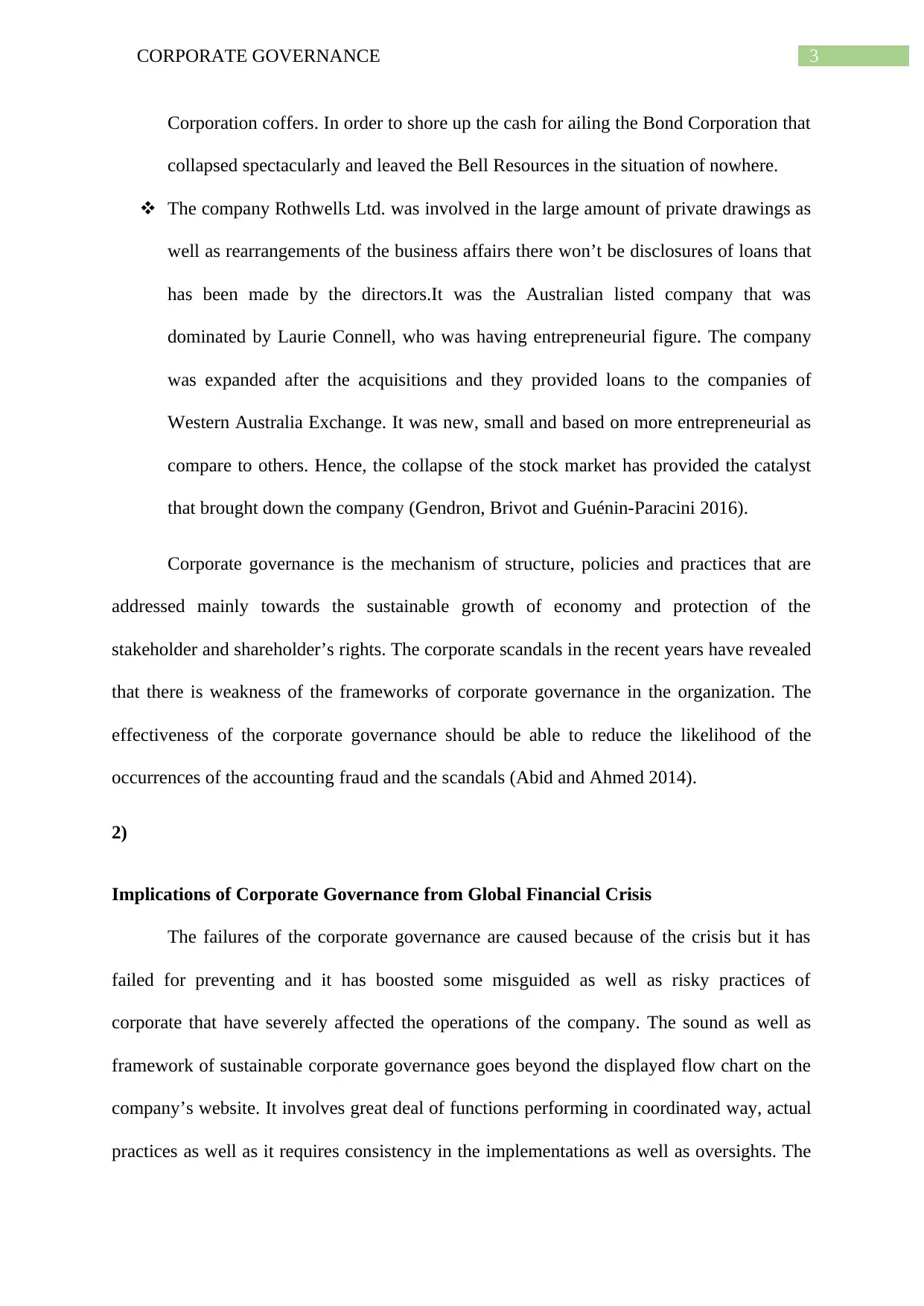
3CORPORATE GOVERNANCE
Corporation coffers. In order to shore up the cash for ailing the Bond Corporation that
collapsed spectacularly and leaved the Bell Resources in the situation of nowhere.
The company Rothwells Ltd. was involved in the large amount of private drawings as
well as rearrangements of the business affairs there won’t be disclosures of loans that
has been made by the directors.It was the Australian listed company that was
dominated by Laurie Connell, who was having entrepreneurial figure. The company
was expanded after the acquisitions and they provided loans to the companies of
Western Australia Exchange. It was new, small and based on more entrepreneurial as
compare to others. Hence, the collapse of the stock market has provided the catalyst
that brought down the company (Gendron, Brivot and Guénin-Paracini 2016).
Corporate governance is the mechanism of structure, policies and practices that are
addressed mainly towards the sustainable growth of economy and protection of the
stakeholder and shareholder’s rights. The corporate scandals in the recent years have revealed
that there is weakness of the frameworks of corporate governance in the organization. The
effectiveness of the corporate governance should be able to reduce the likelihood of the
occurrences of the accounting fraud and the scandals (Abid and Ahmed 2014).
2)
Implications of Corporate Governance from Global Financial Crisis
The failures of the corporate governance are caused because of the crisis but it has
failed for preventing and it has boosted some misguided as well as risky practices of
corporate that have severely affected the operations of the company. The sound as well as
framework of sustainable corporate governance goes beyond the displayed flow chart on the
company’s website. It involves great deal of functions performing in coordinated way, actual
practices as well as it requires consistency in the implementations as well as oversights. The
Corporation coffers. In order to shore up the cash for ailing the Bond Corporation that
collapsed spectacularly and leaved the Bell Resources in the situation of nowhere.
The company Rothwells Ltd. was involved in the large amount of private drawings as
well as rearrangements of the business affairs there won’t be disclosures of loans that
has been made by the directors.It was the Australian listed company that was
dominated by Laurie Connell, who was having entrepreneurial figure. The company
was expanded after the acquisitions and they provided loans to the companies of
Western Australia Exchange. It was new, small and based on more entrepreneurial as
compare to others. Hence, the collapse of the stock market has provided the catalyst
that brought down the company (Gendron, Brivot and Guénin-Paracini 2016).
Corporate governance is the mechanism of structure, policies and practices that are
addressed mainly towards the sustainable growth of economy and protection of the
stakeholder and shareholder’s rights. The corporate scandals in the recent years have revealed
that there is weakness of the frameworks of corporate governance in the organization. The
effectiveness of the corporate governance should be able to reduce the likelihood of the
occurrences of the accounting fraud and the scandals (Abid and Ahmed 2014).
2)
Implications of Corporate Governance from Global Financial Crisis
The failures of the corporate governance are caused because of the crisis but it has
failed for preventing and it has boosted some misguided as well as risky practices of
corporate that have severely affected the operations of the company. The sound as well as
framework of sustainable corporate governance goes beyond the displayed flow chart on the
company’s website. It involves great deal of functions performing in coordinated way, actual
practices as well as it requires consistency in the implementations as well as oversights. The
Paraphrase This Document
Need a fresh take? Get an instant paraphrase of this document with our AI Paraphraser
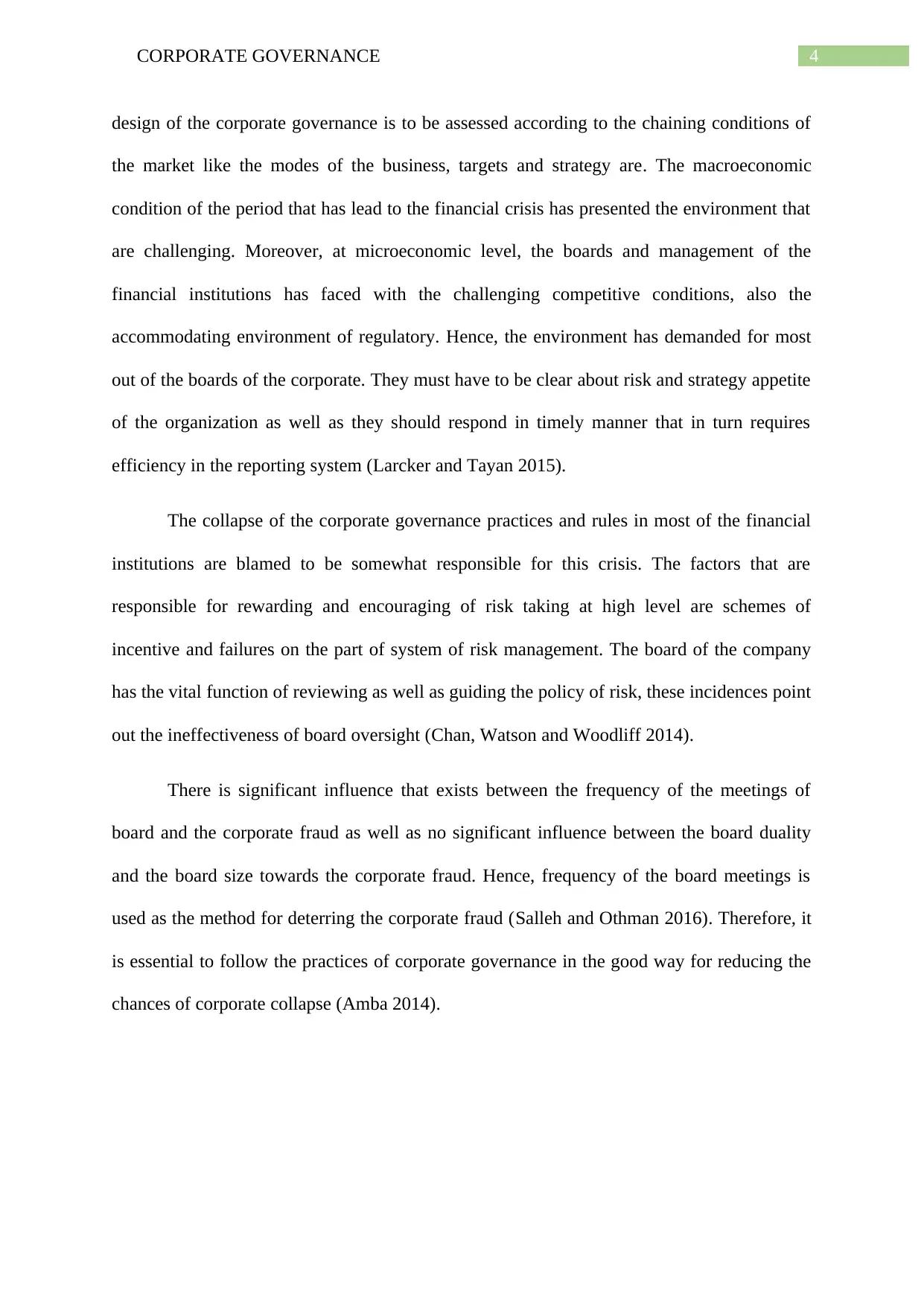
4CORPORATE GOVERNANCE
design of the corporate governance is to be assessed according to the chaining conditions of
the market like the modes of the business, targets and strategy are. The macroeconomic
condition of the period that has lead to the financial crisis has presented the environment that
are challenging. Moreover, at microeconomic level, the boards and management of the
financial institutions has faced with the challenging competitive conditions, also the
accommodating environment of regulatory. Hence, the environment has demanded for most
out of the boards of the corporate. They must have to be clear about risk and strategy appetite
of the organization as well as they should respond in timely manner that in turn requires
efficiency in the reporting system (Larcker and Tayan 2015).
The collapse of the corporate governance practices and rules in most of the financial
institutions are blamed to be somewhat responsible for this crisis. The factors that are
responsible for rewarding and encouraging of risk taking at high level are schemes of
incentive and failures on the part of system of risk management. The board of the company
has the vital function of reviewing as well as guiding the policy of risk, these incidences point
out the ineffectiveness of board oversight (Chan, Watson and Woodliff 2014).
There is significant influence that exists between the frequency of the meetings of
board and the corporate fraud as well as no significant influence between the board duality
and the board size towards the corporate fraud. Hence, frequency of the board meetings is
used as the method for deterring the corporate fraud (Salleh and Othman 2016). Therefore, it
is essential to follow the practices of corporate governance in the good way for reducing the
chances of corporate collapse (Amba 2014).
design of the corporate governance is to be assessed according to the chaining conditions of
the market like the modes of the business, targets and strategy are. The macroeconomic
condition of the period that has lead to the financial crisis has presented the environment that
are challenging. Moreover, at microeconomic level, the boards and management of the
financial institutions has faced with the challenging competitive conditions, also the
accommodating environment of regulatory. Hence, the environment has demanded for most
out of the boards of the corporate. They must have to be clear about risk and strategy appetite
of the organization as well as they should respond in timely manner that in turn requires
efficiency in the reporting system (Larcker and Tayan 2015).
The collapse of the corporate governance practices and rules in most of the financial
institutions are blamed to be somewhat responsible for this crisis. The factors that are
responsible for rewarding and encouraging of risk taking at high level are schemes of
incentive and failures on the part of system of risk management. The board of the company
has the vital function of reviewing as well as guiding the policy of risk, these incidences point
out the ineffectiveness of board oversight (Chan, Watson and Woodliff 2014).
There is significant influence that exists between the frequency of the meetings of
board and the corporate fraud as well as no significant influence between the board duality
and the board size towards the corporate fraud. Hence, frequency of the board meetings is
used as the method for deterring the corporate fraud (Salleh and Othman 2016). Therefore, it
is essential to follow the practices of corporate governance in the good way for reducing the
chances of corporate collapse (Amba 2014).
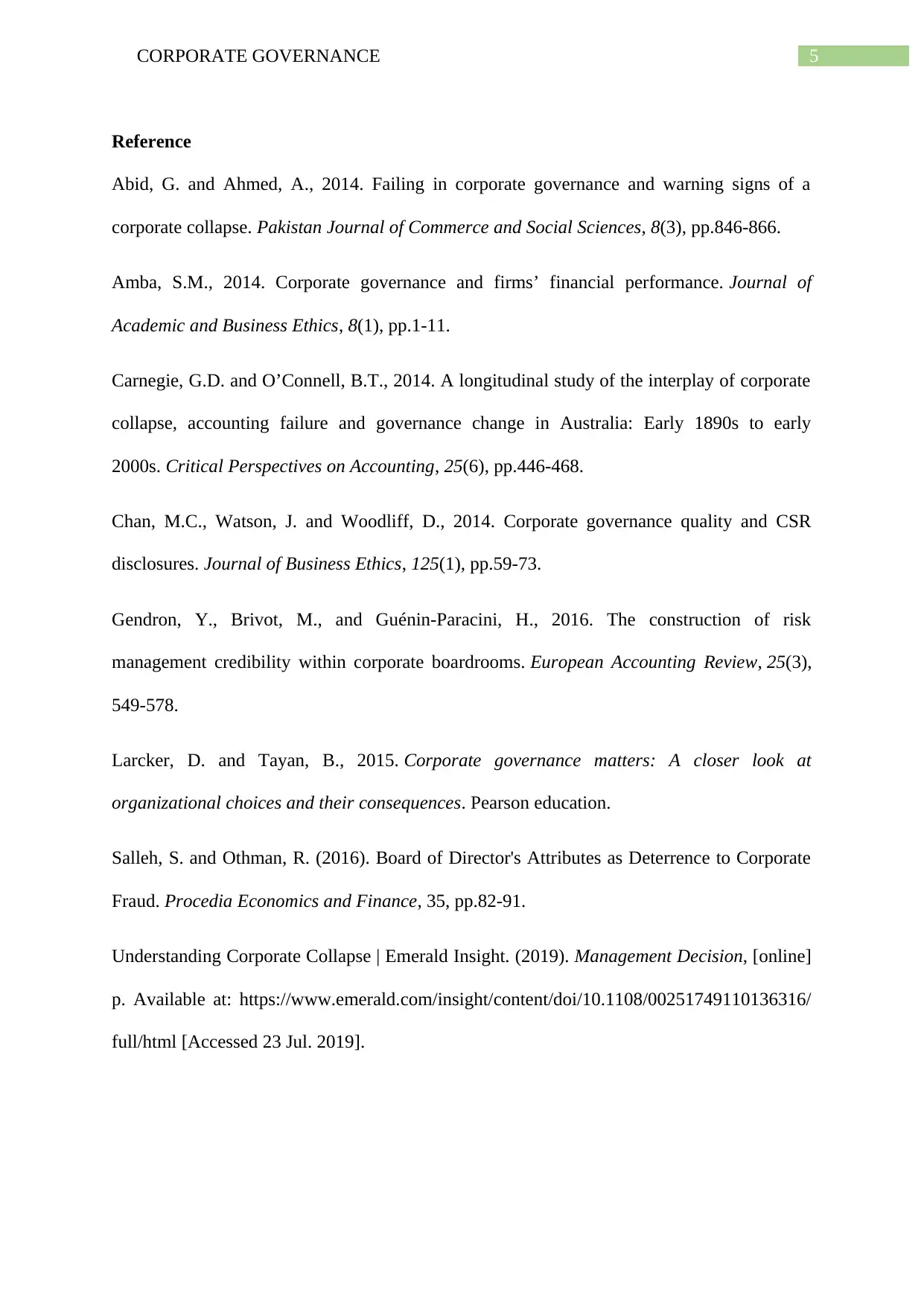
5CORPORATE GOVERNANCE
Reference
Abid, G. and Ahmed, A., 2014. Failing in corporate governance and warning signs of a
corporate collapse. Pakistan Journal of Commerce and Social Sciences, 8(3), pp.846-866.
Amba, S.M., 2014. Corporate governance and firms’ financial performance. Journal of
Academic and Business Ethics, 8(1), pp.1-11.
Carnegie, G.D. and O’Connell, B.T., 2014. A longitudinal study of the interplay of corporate
collapse, accounting failure and governance change in Australia: Early 1890s to early
2000s. Critical Perspectives on Accounting, 25(6), pp.446-468.
Chan, M.C., Watson, J. and Woodliff, D., 2014. Corporate governance quality and CSR
disclosures. Journal of Business Ethics, 125(1), pp.59-73.
Gendron, Y., Brivot, M., and Guénin-Paracini, H., 2016. The construction of risk
management credibility within corporate boardrooms. European Accounting Review, 25(3),
549-578.
Larcker, D. and Tayan, B., 2015. Corporate governance matters: A closer look at
organizational choices and their consequences. Pearson education.
Salleh, S. and Othman, R. (2016). Board of Director's Attributes as Deterrence to Corporate
Fraud. Procedia Economics and Finance, 35, pp.82-91.
Understanding Corporate Collapse | Emerald Insight. (2019). Management Decision, [online]
p. Available at: https://www.emerald.com/insight/content/doi/10.1108/00251749110136316/
full/html [Accessed 23 Jul. 2019].
Reference
Abid, G. and Ahmed, A., 2014. Failing in corporate governance and warning signs of a
corporate collapse. Pakistan Journal of Commerce and Social Sciences, 8(3), pp.846-866.
Amba, S.M., 2014. Corporate governance and firms’ financial performance. Journal of
Academic and Business Ethics, 8(1), pp.1-11.
Carnegie, G.D. and O’Connell, B.T., 2014. A longitudinal study of the interplay of corporate
collapse, accounting failure and governance change in Australia: Early 1890s to early
2000s. Critical Perspectives on Accounting, 25(6), pp.446-468.
Chan, M.C., Watson, J. and Woodliff, D., 2014. Corporate governance quality and CSR
disclosures. Journal of Business Ethics, 125(1), pp.59-73.
Gendron, Y., Brivot, M., and Guénin-Paracini, H., 2016. The construction of risk
management credibility within corporate boardrooms. European Accounting Review, 25(3),
549-578.
Larcker, D. and Tayan, B., 2015. Corporate governance matters: A closer look at
organizational choices and their consequences. Pearson education.
Salleh, S. and Othman, R. (2016). Board of Director's Attributes as Deterrence to Corporate
Fraud. Procedia Economics and Finance, 35, pp.82-91.
Understanding Corporate Collapse | Emerald Insight. (2019). Management Decision, [online]
p. Available at: https://www.emerald.com/insight/content/doi/10.1108/00251749110136316/
full/html [Accessed 23 Jul. 2019].
⊘ This is a preview!⊘
Do you want full access?
Subscribe today to unlock all pages.

Trusted by 1+ million students worldwide
1 out of 6
Related Documents
Your All-in-One AI-Powered Toolkit for Academic Success.
+13062052269
info@desklib.com
Available 24*7 on WhatsApp / Email
![[object Object]](/_next/static/media/star-bottom.7253800d.svg)
Unlock your academic potential
Copyright © 2020–2025 A2Z Services. All Rights Reserved. Developed and managed by ZUCOL.




